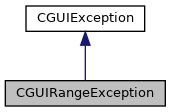CGUIRangeException Class Reference
The exception is used to indicate the range errors. More...
#include <GUIRangeException.h>
Inheritance diagram for CGUIRangeException:

Public Member Functions | |
| CGUIRangeException (const CGUIRangeException &kSource) | |
| CGUIRangeException (const eC_Value &vMax=eC_MAXVALUE, const eC_Value &vMin=eC_MINVALUE) | |
| ~CGUIRangeException () | |
| CGUIRangeException & | operator= (const CGUIRangeException &kSource) |
| virtual eC_String | Report () const |
 Public Member Functions inherited from CGUIException Public Member Functions inherited from CGUIException | |
| CGUIException () | |
| virtual | ~CGUIException () |
| virtual eC_String | Report () const |
Detailed Description
The exception is used to indicate the range errors.
Constructor & Destructor Documentation
◆ CGUIRangeException() [1/2]
| CGUIRangeException::CGUIRangeException | ( | const eC_Value & | vMax = eC_MAXVALUE, |
| const eC_Value & | vMin = eC_MINVALUE |
||
| ) |
Constructor.
- Parameters
-
vMax The maximum value of the range. vMin The minimum value of the range.
◆ ~CGUIRangeException()
| CGUIRangeException::~CGUIRangeException | ( | ) |
Destructor.
◆ CGUIRangeException() [2/2]
| CGUIRangeException::CGUIRangeException | ( | const CGUIRangeException & | kSource | ) |
Copy-constructor.
- Parameters
-
kSource Source object to be copied.
Member Function Documentation
◆ operator=()
| CGUIRangeException & CGUIRangeException::operator= | ( | const CGUIRangeException & | kSource | ) |
Operator= method.
- Parameters
-
kSource Source object to be copied.
- Returns
- This instance.
◆ Report()
|
virtual |
Report the message of the exception.
- Returns
- The message of the exception.
Reimplemented from CGUIException.
The documentation for this class was generated from the following file:
